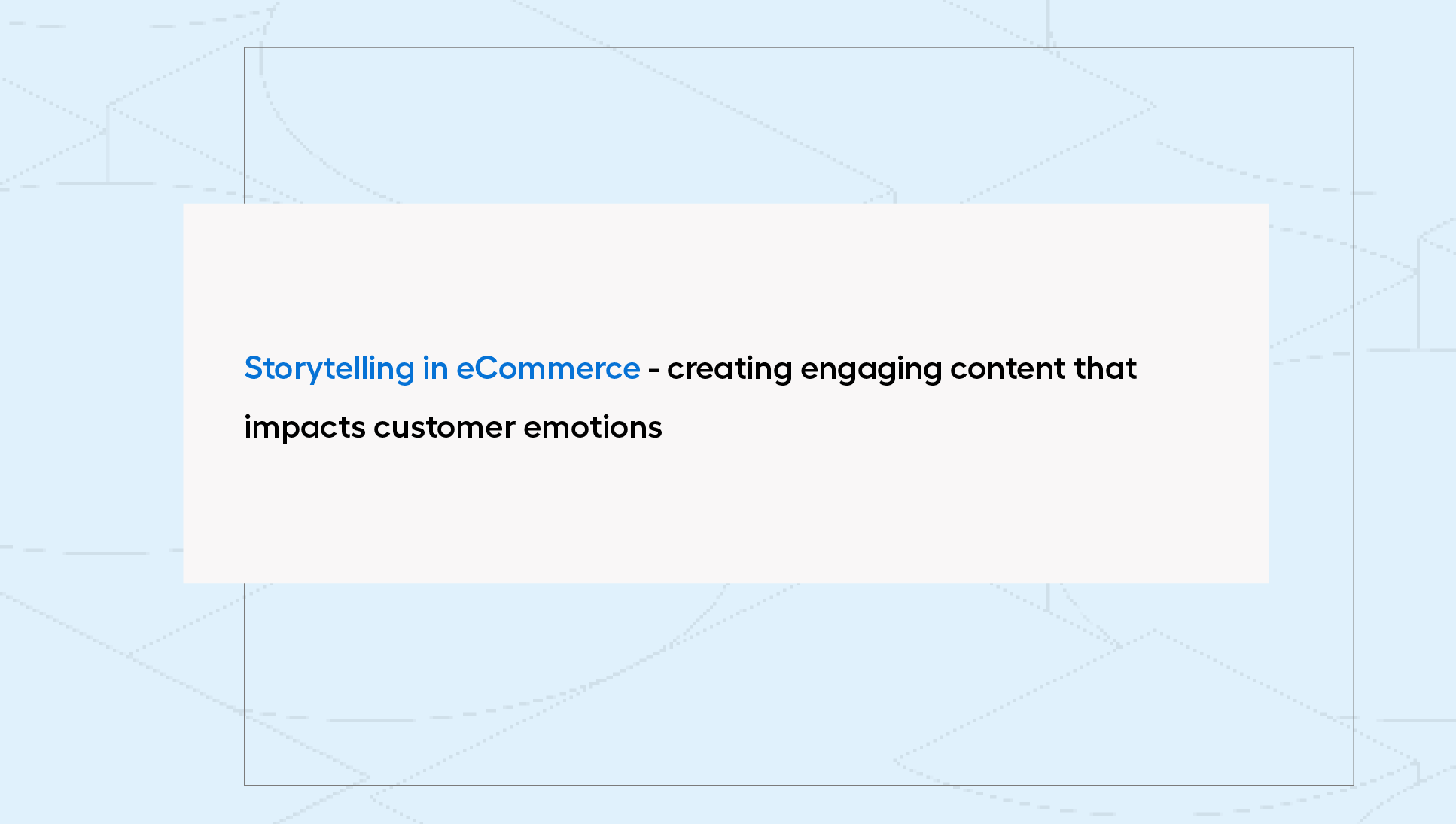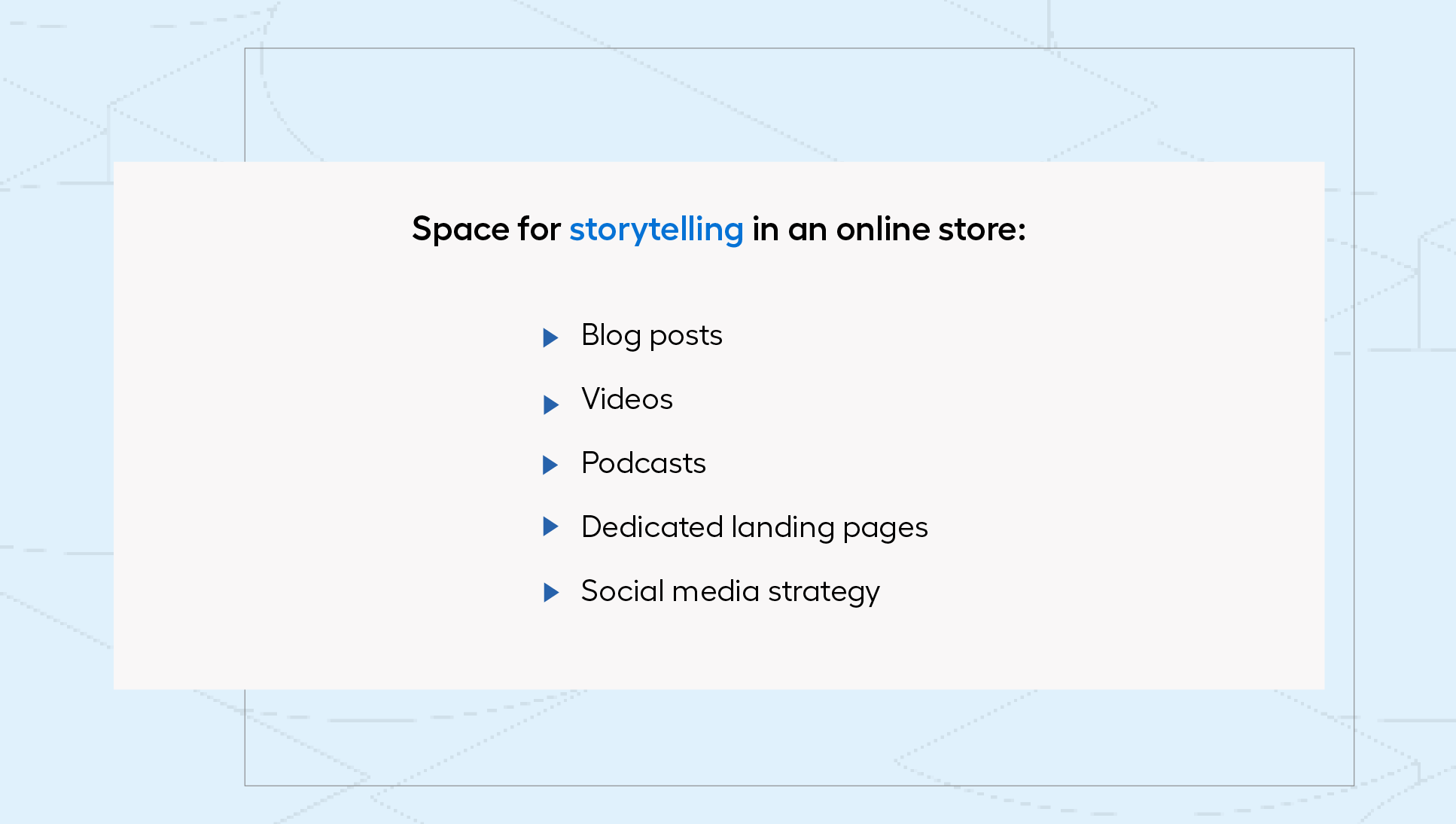Table of contents
- What is storytelling?
- How to use storytelling in an online store?
- Data storytelling - when numbers tell the story
- Why does storytelling work?
- 5 tips on how to sell online using storytelling
- When does storytelling in eCommerce not work?
- Storytelling in an online store - a higher level of communication with the customer
- remember important information - a story gives information context and makes it more meaningful and easier to remember. By using storytelling in your online store, you can present key information about products or services in an engaging and memorable way. For example, instead of just presenting the technical specifications of a product, you can tell a story about how the product can solve a customer's problem.
- encourage discussion - stories prompt reflection and exchange of views. A well-told story can evoke various emotions in customers, which in turn may prompt them to discuss the product, brand, or industry. This is an excellent opportunity to build relationships with customers and gain valuable feedback.
- explain complex issues - stories are a great way to explain complex issues in a simple and understandable manner. By using storytelling in your online store, you can help your customers better understand how products or services work, as well as the principles of the industry.
- build bonds - when we listen to stories, we identify with the characters and their experiences. This allows us to build an emotional bond with the brand that tells these stories. Storytelling in an online store can help you create stronger relationships with customers based on trust and mutual understanding.
What do all online stores have in common? Content – product descriptions, homepage texts, and advertising slogans fill websites. Ordinary texts are everywhere, but not everyone knows how to use them to capture the user's interest and evoke emotions and a sense of attachment to the brand. These effects can be achieved through storytelling, the skill of engaging storytelling. By utilising it, you can transform "dry information" into memorable narratives. As a result, storytelling becomes an indispensable tool in the fight for customer attention and brand building in the eCommerce world. Read the article and learn how to create emotionally charged content in your e-shop!
What is storytelling?
Storytelling is simply telling stories. The strength lies in its simplicity – skillful storytelling is an art that can be successfully used in business, especially in sales. So, where is the place for storytelling in an online store?

Storytelling finds its place at many levels of customer communication – from conveying product information to building a narrative around the brand. In this way, simple messages can be turned into engaging stories that affect the emotions and imaginations of customers. This approach opens up the space for creating deeper relationships with shoppers, building loyalty, and creating memorable (and standout) experiences.
For example, imagine you are looking for a durable jacket for a mountain expedition. You come across Patagonia's store website, where you can read about the process of designing and creating specialised clothing. You learn about the meticulous testing of materials, stories of satisfied customers, and the ideas that inspired the brand's creators. Such a presentation of the product will certainly stick in your memory and make you at least consider buying from Patagonia. This is the essence of effective storytelling – it doesn't just convey "dry facts" but creates a coherent and compelling narrative that makes purchasing decisions more personal and valuable for customers.
 Example of storytelling in Patagonia’s store
Example of storytelling in Patagonia’s store
How to use storytelling in an online store?
If you look at the functioning of a classic online store, you'll quickly notice that storytelling elements can be incorporated almost everywhere, at every stage of the purchasing process. This could be a captivating banner on the homepage, a product description on its page, articles on the company blog, or a dedicated landing page presenting the brand's stories and visions. Now that you know where to place content featuring storytelling, it's worth considering how to do it effectively?

The first method of utilising storytelling is to consistently incorporate this type of narrative into customer communication, which includes both developing and enriching the existing company story and creating new stories associated with the brand. An excellent example of this approach is the online store PsiBufet, which offers personalised dog food (also available in a popular subscription model). On the store's website, you'll find stories of satisfied dog owners, practical tips, and funny anecdotes from the lives of dogs. This type of communication perfectly meets the needs of customers for whom pets are a very important part of life, making it an effective way to build relationships and engagement.
 Storytelling in PsiBufet’s store
Storytelling in PsiBufet’s store
The second method is occasional storytelling, used during special occasions such as holiday campaigns. A good example here is Coca-Cola, whose stories about Santa Claus in a red suit have become so recognizable that they have changed the global perception of this figure. Using this type of narrative at specific times can significantly increase interest in the store's offer and strengthen the emotional connection with the brand.
Regardless of the form of storytelling you choose, it is essential that the stories are authentic, consistent with the brand's values, and aim to build an emotional bond. It is important that every story you present reflects the values and mission of your company, creating a strategy that will help you achieve your goals.
Data storytelling - when numbers tell the story
Engaging stories can be created not only with words but also with numbers, or more precisely, with data. Besides traditional narratives based on words, data storytelling is gaining increasing popularity in eCommerce. This method involves creating engaging stories using numbers, charts, and infographics that visually present data and give it context.
Data storytelling allows for presenting complex information in an understandable and attractive way for the audience. This way of creating content can be particularly effective in presenting value to customers in the B2B sector. For example, you can present case studies of successful implementations of your products or services. You can also show a summary of results over the years to highlight that your company is a reliable partner. More and more tools are emerging on the market that help better manage and analyse data, often using artificial intelligence. This allows you to easily analyse even vast amounts of data (big data), extract what is key, and present it in a digestible and convincing form for your customers.
Why does storytelling work?
People are naturally inclined to engage with stories – we reach for movies or books with intriguing plots or simply enjoy stories that accompany us during everyday conversations. Stories surround us at every step, becoming an integral part of our lives. We remember and repeat stories that affect our emotions, bring back memories, or simply have positive associations. For this reason, using storytelling in an online store is a strategy that naturally builds an emotional connection with your customers, but these are not all the benefits. A well-told story helps:
5 tips on how to sell online using storytelling
Deciding to use storytelling in your e-shop means understanding that creating any story won't suffice to stand out from the competition and build lasting relationships with customers. To achieve this, you need an effective marketing strategy. Wondering where to start creating it? Here are 5 practical tips to help you effectively use storytelling in eCommerce.
Use different types of content
Using different types of content is crucial for effective storytelling. Adapt the presented materials to the goals – enrich the text with visual elements such as photos, graphics, charts, videos, or 3D visualisations. For example, if you are presenting the story of your brand, include a film illustrating its development. To show how a product can improve users' lives, use attractive graphics and charts that highlight its benefits.
Prioritise quality
Write (or create other types of content) about what makes your brand unique, focusing on original and authentic stories that resonate with the audience. Authenticity in storytelling is key – its lack can deter potential customers, making them feel manipulated. By offering content that is sincere and well thought out, you increase the chances that the brand's story will be remembered and mentioned more often.
Speak the language of your audience
Ensure that the way you present the story is enjoyable for the user. Avoid complicated language, adapting the style and tone of communication to the expectations of your target group. Simple and accessible language makes it easier for the audience to identify with the message and improves brand perception.
Remember to analyze results
Systematically tracking the effects of storytelling activities is essential to understand how they impact engagement and sales. You can do this, for example, by measuring how many people placed an order after viewing the page describing your brand's story. Regular analysis will allow you to assess the effectiveness of the strategy and introduce changes aimed at increasing the strategy's effectiveness.
Combine storytelling with the power of social proof
Finally, combine storytelling with the power of social proof. Opinions and reviews from other users can enhance the credibility of your stories. Showing that other customers share positive experiences related to your products increases the chance of attracting new customers.
In conclusion, don't forget the essence of storytelling, which is emotions. Without them, the stories told will be "flat" and unnoticed. Try to evoke various feelings – from joy to surprise. For example, a funny video showing everyday challenges can reduce distance and make customers feel understood. On the other hand, a compelling story of building a brand can be inspiring for the audience. Remember that emotions are the bridge connecting the customer to your brand, so it's worth investing in building and nurturing them through thoughtful and engaging storytelling strategies.
When does storytelling in eCommerce not work?
Although storytelling is an art that can be creatively transformed and practically used in any industry, it's essential to remember that there are no universal solutions in business. What works in one business may not yield the expected results in another. Therefore, it's crucial to tailor your storytelling strategy to the specificities of your company, product, and target audience.
The key to success is understanding the needs and expectations of customers. Consider what interests them, what motivates them, and what problems they want to solve. The effectiveness of a storytelling strategy depends on many factors, such as the nature of the product, the target audience, competition, and budget.
It's also important to consider that not every customer is open to storytelling. Some people prefer straightforward and factual communication, while others appreciate engaging stories. It's essential to adapt the strategy to the needs and expectations of the audience.
Storytelling in an online store - a higher level of communication with the customer
Storytelling in eCommerce is not just a way to present products but primarily a technique for building deeper and emotionally charged connections with buyers. According to industry reports (Search Engine Watch), well-utilised storytelling can increase conversion rates by up to 30%.
So don't wait any longer – start creating engaging stories in your online store and see how storytelling can transform your approach to sales and customer relationships. Build a strong, emotional bond and make your customers not only buy your products but also think about your brand every day!



